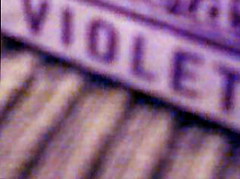Tonight I saw The Hot Mikado at UCLA. It was a production of the undergraduate musical theater program and had several of my students in it, and it was absolutely wonderful. I was totally impressed by how talented these kids are. They've been working really hard on this show and it totally paid off - every single one of them were strong dancers with gorgeous voices and great acting talent. I'm completely amazed.
Now, unfortunately, the show itself was not nearly as breathtaking as the performers in it. It was vaguely postmodern in that it was self-referential, but it was mostly intellectually empty. And the racial politics made me cringe. It was a mostly white cast performing a show set in a Harlem jazz club/Japan. The recurring joke was "Hey! This note is written in Japanese. Oh, wait, WE'RE Japanese." There was some ethnic diversity in the cast, but they were for the most part white, especially the boys. The exception was Sterling Suileman as The Mikado. He entered for a show-stopping tap number at the top of Act II, doing what was at moments an excellent Sammy Davis Jr. impersonation, although it faded in and out. It was interesting to have the only African-American man onstage be the most powerful character.
The Mikado's son, with no family resemblance was Chris Fore as Nanki-Poo and he was completely compelling, which is pretty impressive for a role with the development of a cartoon character. He was a cross between the sweet but vulnerable "good guy" (think Jimmy Stewart)and Micky Mouse, complete with high voice. It was absolutely charming. From the moment he opened his mouth I wanted him to get the girl, and I wanted to see him perform more romantic lead and earnest young man roles.
The other highpoint was Robert Bastaron as KoKo, the Lord High Executioner. Robert's interpretation of the character didn't seem to make a lot of sense at first, because he didn't seem too particularly heterosexual. He wore thick glasses and ran around the stage telling us that certain dance moves were "Fosse" or "Busby Berkeley." I kept thinking "I'm supposed to believe this guy really wants to marry Yum-Yum? Please. He'd be happier with one of the boys." But the queer content came out when he had to seduce Katishaw. She was an 'older woman' and they very quickly established a very kinky S/M relationship. KoKo as a kinky bottom thoroughly resolved his latent homosexuality in my opinion, and I loved the queerness of the heterosexual relationship. If he had to be in the closet, what a fun way to do it. In my opinion, they could have gone a little more over the top with the S/M. I would have liked to see some fetish gear, handcuffs, something. Instead they tied KoKo up with his own tie, which was cute and very resourceful, but a little too vanilla for how clearly naughty their relationship was.
In comparison to the boys, the girls in the play were utterly forgettable, altough they all performed flawlessly. Lana as Yum-Yum had a beautiful voice and was in general quite adorable.
The costumes and dancing were really spectacular, and I could have just watched them dancing forever. The men's costumes were very strange, though beautiful. The men wore brightly colored Zoot Suits (now, I associate with Chicano/Latino culture, but that could just be my LA context) but with lots of sequins on them, decorating the seams of their pants and accenting their suitcoats. They were also decorated on the back and arm with vaguely Japanese designs such as bonsai trees and Japanese characters. The girls wore rather more plain '40s-style dresses that matched the men's suits, though some of them had sequins on the heels of their shoes, which I thought was pretty hot. One incongrous costuming choice was that while all the other men wore dress shirt and ties, if not glittery suitcoats, Chester See only wore a men's undershirt with a collar and tie - no dress shirt. Though he has lovely arms and biceps to show off, it didn't really make sense why he would be that much less formal than the other men.
The set initially appeared to be a Shojii (sp?) screen backdrop, onto which various designs and backdrops were projected, but it opened up to reveal a Cotton-Club-like set with twinkly lights on the steps and around a second proscenium. Altogether the combination of style elements traced the history of the show: vague Japanisme layered on top of a 1940s swing/jazz version of a musical about Japan that actually has nothing to do with Japan. There was Gilbert and Sullivan's appropriation of Japan and then white appropriation of African-American music. I'm not so sure the production had a good critical awareness of its politics and seemed to prefer the strategy of being so overfull of signifiers that it distracted you from what it was doing. But really, I was so well entertained and visually stimulated, that I cared very little about what the show was saying. I loved the whole thing and highly recommend it if you happen to be LA this weekend or next. Go support my students!
Purple Rain
-
I went to Minneapolis to check out the stage version of *Purple Rai*n.
There were many issues but the one that sticks in my craw a month after
seeing the...
1 week ago

0 comments:
Post a Comment